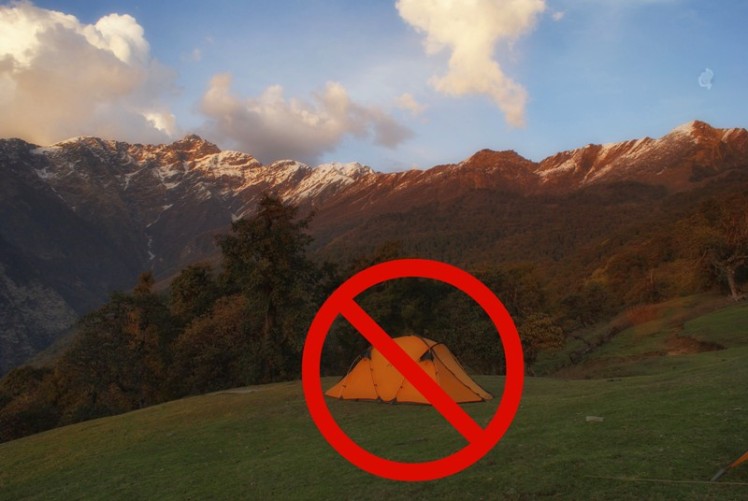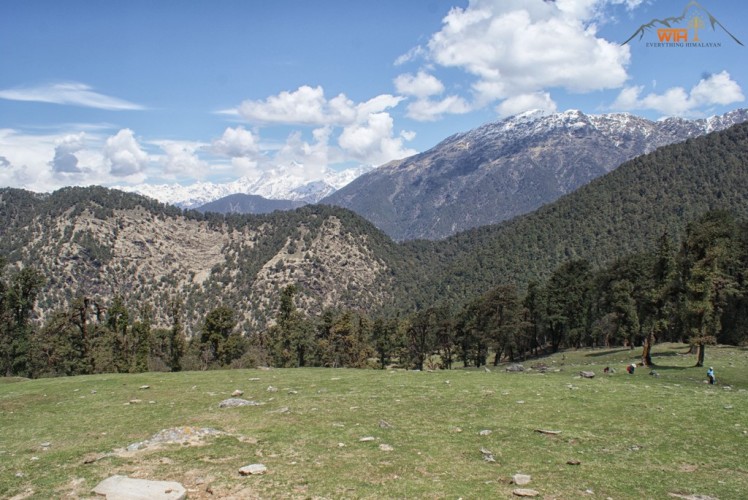
This winter season, Uttarakhand Forest Officials set out to protect the state wildlife by bringing in regulations. Trek like Har-Ki-Dun is closed for trekkers in Govind National Park for the Winter Season. The Forest Officials stated doing so to help the animals a peaceful transition time for migration and hibernation.
Just ahead of winter, the Forest Department has withdrawn permission to camp inside Kedarnath Musk Deer Sanctuary. Trekkers will no longer be allowed to camp at Rohini Bughyal and Bhrujgali meadows on the famous Deoriatal to Chandrashila Trek. Although taking the 14 km forest trail from Deoriatal to Chopta is permitted.
The rationale behind withdrawing camping permissions
The prime motive of this move is linked with the conservation of the endangered white-bellied musk deer. This solitary animal resides in the Kedarnath Wildlife Sanctuary and is poached indiscriminately for its musk pod. A musk pod is found in the abdomen of the male musk Deer. The musk pod emits a pleasant aroma that is highly sort after for its cosmetic properties. The population has dwindled from 600 – 1000 to mere 100 in last three decades alone.
The State Forest department says checking poaching is difficult with limited funds, lack of Forest guards and difficult terrains. The shortage of patrolling staff makes it near impossible to guard the vast forest land. About one-third of the posts lie vacant in Kedarnath Wildlife Sanctuary in the department. Most Guards are nearing the age of retirement and replacements are hard to find.
Trek Tourism has risen exponentially at Sari and Chopta in the last few years. Organized trekking groups have started to run fixed itinerary treks inside Kedarnath Musk Deer Sanctuary. The Forest Officials find it impossible to keep a control over camping activities inside the Sanctuary. The problem of littering at the forested trail and the campsite has come into the light lately. The quiet meadows of Rohini Bughyal and Bhrujgali (once only used by local villagers and shepherds) now see a presence of multiple trekking agencies. Suddenly the quiet sanctuary has been taken over by trek tourists.
The money collected from Camping Permission and Environment fee do not always reach the Forest Department collections. Under the table deal for the entire trekking season is done among some Trek Agencies and Officials. It looks like everyone is benefiting but the Sanctuary and its creatures.

Is withdrawing camping permission inside the Forest going to help?
The answer to this question depends on to help who? If the conservation of Musk Deer from poachers is the cause then banning camping does little. It only helps the understaffed Forest Department to channelise their resources in looking at other matters than the impact of trek tourism.
Having said that, banning camping inside the forest has other benefits. It will help in avoiding the ecological impact from unregulated trek tourism. This can help in minimizing human encroachment in the protected land reserved for the animals and birds. And that is not bad at all.
Any reproduction of this Blog (including Pictures) without obtaining a written permission will be subject to copyright violation. Strict Legal action will be taken. You may write to us at vaibhav@wanderthehimalayas.com for such requests.

Thanks for the info. It’s a great move. Even otherwise there has to be a system to limit the humans trekking and camping in these ecologically sensitive places. Easier to think but hard to implement though. Would love to reblog with your kind permission Vaibhav!
LikeLiked by 1 person
Thanks Arvind. Feel free to reblog at will.
LikeLiked by 1 person
Thanks Vaibhav 🙂
LikeLike
Reblogged this on Curated Experiences & Impressions!.
LikeLike
I think, no matter what reasons compelled them to take this step, this would be really beneficial for local ecosystems. Looking forward to more of this kind of steps, but instead of banning camping, regulated camping at other places, I think, would be better. But given the fact that Chandrashila was almost on the verge of being another Kheerganga, or Triund, I welcome this step wholeheartedly. Would also like to reblog if you kindly allow.
LikeLiked by 1 person
Thanks for sharing your thoughts. Feel free to Reblog:-)
LikeLiked by 1 person
Reblogged this on wandering wonders… and commented:
In the behest of the malignantly growing trek-tourism and its adverse effects on local ecosystems, this decision could be exemplary in many ways given the fact that the forest officials feel the need.
Sharing this post which was originally published by WANDER THE HIMALAYAS.
LikeLike
Thanks, reblogged this in Wandering Wonders (https://esotericperceptions.wordpress.com/).
LikeLike
So rightly said Vaibhav. Some places just need to be left unspoiled by restricting human interference. Its important for the ecology and like you shared endangered fauna and flora too. I also feel that as travel passionate people we can be a bit responsible and keep some places off record ….. because thereafter the place is no longer untouched. It starts facing the brunt of many irresponsible tourists and commercialization
LikeLiked by 1 person
Deoriatal to Chandrashila is a very popular trail, so its a good move for them to set up some restrictions. I saw how Rohini Bugyal serves as a permanent midway stop for the commercial agencies. The forest authorities should be proactive in containing the harmful effects of increasing footfall.
LikeLiked by 1 person
Reblogged this on subhajitbanerjee.
LikeLike
I completely agree with you..Banning trek tourism and camping will help forest management divert their resources and manage the cases that need more attention. Pollution and poaching may come down to an extent with this ban. The same thing I observed in Rohtang Pass and Solang Valley where all commercial activities were banned on the pretext of pollution. Don’t know if that started again.
LikeLike
I agree. It’s a good step. More such initiatives are needed to conserve the beautiful places.
LikeLiked by 1 person